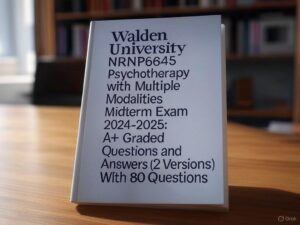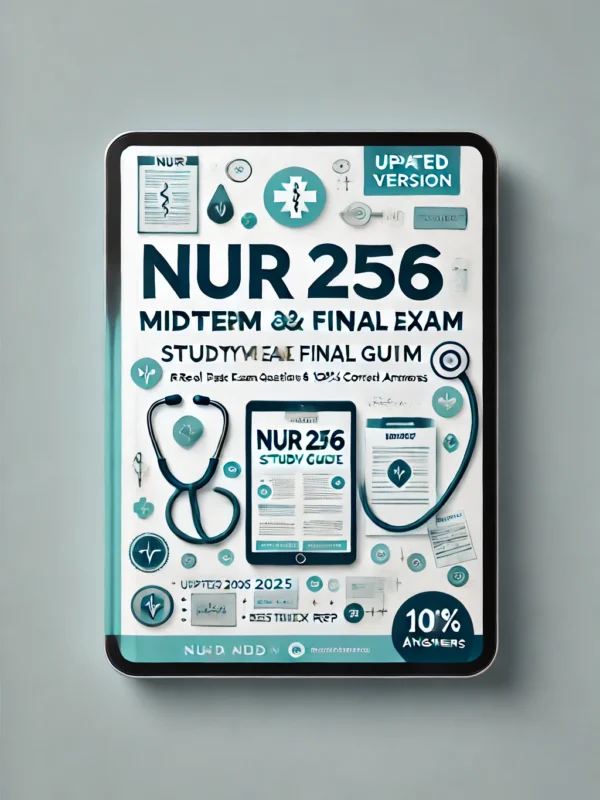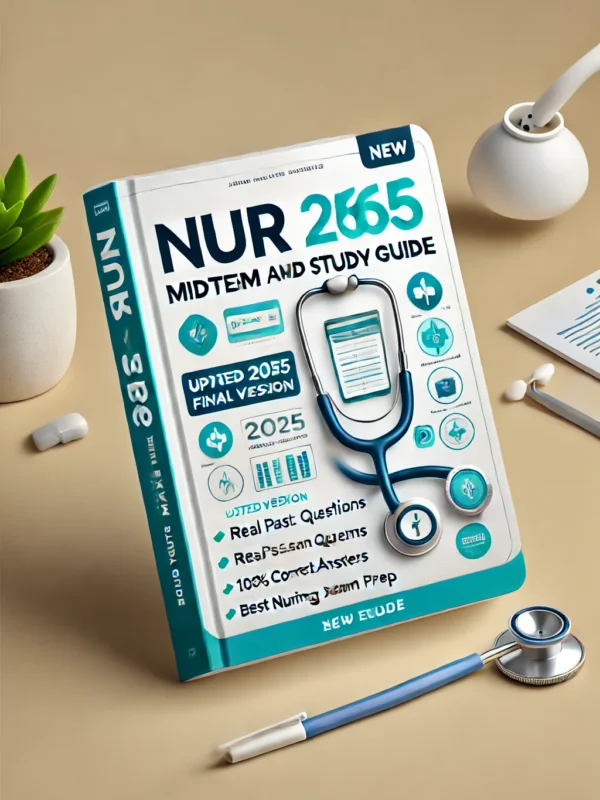Prepare for the Walden University NRNP6645 Psychotherapy with Multiple Modalities Midterm Exam for 2024-2025 with this A+ graded resource, featuring 80 questions across 2 versions with detailed answers. Designed for nursing and mental health students, this guide covers key psychotherapy concepts, including cognitive-behavioral, psychodynamic, humanistic, and integrative modalities. Each version offers 40 carefully curated questions that mirror the midterm format, with A+ graded answers providing in-depth explanations to enhance your understanding. This resource is your ultimate tool to excel in the NRNP6645 midterm exam.
Preview
1. Mrs. Williams is 76 years old and comes in to have a wound checked on her right leg.
She fell a month ago, and the wound has not healed. She is concerned that something
is wrong. The nurse practitioner examines the wound and sees that it has been
cleaned properly and has no signs of infection. The edges are approximated, but the
skin around the wound is red and tender to touch. The best response regarding Mrs.
Williams’ concern is:
a) Wound healing for older people may take up to four times longer than it does for younger
people.
b) Let us talk about what you are eating.
c) Had you come in earlier, I would have ordered medicine that would have healed that right
up.
d) I will order an antibiotic to prevent infection.
Correct answer: a)
Rationale:
Wound healing in older adults can indeed take longer due to decreased skin renewal and
slower healing processes. The other responses are either irrelevant or provide false hope
(i.e., there’s no medicine that will heal a wound quickly).
2. The nurse practitioner is conducting patient rounds in a long-term care facility. As
she talks with Mrs. Jones, she notices that her arms and elbows are excoriated and the
skin is shearing. The nurse practitioner explains to the staff that Mrs. Jones needs
frequent assessment of her skin and protection provided to prevent skin breakdown
because:
a) Her lack of activity causes the skin to tear.
b) Fat has redistributed to the abdomen and thighs, leaving bony surfaces in areas such as
the face, hands, and sacrum. This can result in injury.
c) She has lost weight and is in jeopardy of falling.
d) She picks at herself and causes skin breakdown.
Correct answer: b)
Rationale:
As people age, fat is redistributed to the abdomen and thighs, leaving the skin over bony
areas more vulnerable to pressure and friction, which can cause shearing and skin
breakdown. Lack of activity may contribute to pressure ulcers, but it’s not the primary
cause of skin tearing here.
3. Mr. James is 91 years old. His daughter notices that he has bruises and lacerations
on his arms and reports this to the nurse practitioner, who tells her that older people
bruise easily due to their fragile blood vessels. The skin lacerations happen because
he has thin skin. Even so, the nurse practitioner assures the daughter that she will
investigate further to ensure that he is getting proper care. She says this because she
understands that:
a) These markings on the patient’s skin are part of aging skin.
b) Bruises and lacerations can indicate inadequate care.
c) The daughter needs assurance that her father is okay.
d) The patient is being abused.
Correct answer: b)
Rationale:
Bruises and lacerations in older adults can be due to natural aging processes, but they can
also signal that the patient is not receiving adequate care. It’s important to assess the
situation further to ensure proper care is being provided.
She fell a month ago, and the wound has not healed. She is concerned that something
is wrong. The nurse practitioner examines the wound and sees that it has been
cleaned properly and has no signs of infection. The edges are approximated, but the
skin around the wound is red and tender to touch. The best response regarding Mrs.
Williams’ concern is:
a) Wound healing for older people may take up to four times longer than it does for younger
people.
b) Let us talk about what you are eating.
c) Had you come in earlier, I would have ordered medicine that would have healed that right
up.
d) I will order an antibiotic to prevent infection.
Correct answer: a)
Rationale:
Wound healing in older adults can indeed take longer due to decreased skin renewal and
slower healing processes. The other responses are either irrelevant or provide false hope
(i.e., there’s no medicine that will heal a wound quickly).
2. The nurse practitioner is conducting patient rounds in a long-term care facility. As
she talks with Mrs. Jones, she notices that her arms and elbows are excoriated and the
skin is shearing. The nurse practitioner explains to the staff that Mrs. Jones needs
frequent assessment of her skin and protection provided to prevent skin breakdown
because:
a) Her lack of activity causes the skin to tear.
b) Fat has redistributed to the abdomen and thighs, leaving bony surfaces in areas such as
the face, hands, and sacrum. This can result in injury.
c) She has lost weight and is in jeopardy of falling.
d) She picks at herself and causes skin breakdown.
Correct answer: b)
Rationale:
As people age, fat is redistributed to the abdomen and thighs, leaving the skin over bony
areas more vulnerable to pressure and friction, which can cause shearing and skin
breakdown. Lack of activity may contribute to pressure ulcers, but it’s not the primary
cause of skin tearing here.
3. Mr. James is 91 years old. His daughter notices that he has bruises and lacerations
on his arms and reports this to the nurse practitioner, who tells her that older people
bruise easily due to their fragile blood vessels. The skin lacerations happen because
he has thin skin. Even so, the nurse practitioner assures the daughter that she will
investigate further to ensure that he is getting proper care. She says this because she
understands that:
a) These markings on the patient’s skin are part of aging skin.
b) Bruises and lacerations can indicate inadequate care.
c) The daughter needs assurance that her father is okay.
d) The patient is being abused.
Correct answer: b)
Rationale:
Bruises and lacerations in older adults can be due to natural aging processes, but they can
also signal that the patient is not receiving adequate care. It’s important to assess the
situation further to ensure proper care is being provided.












Reviews
There are no reviews yet.